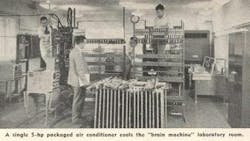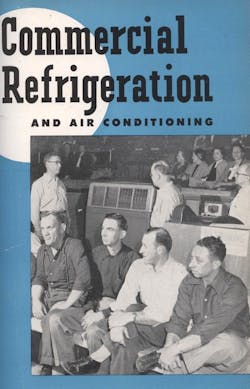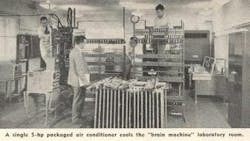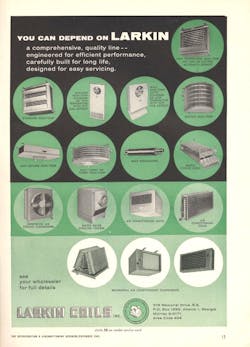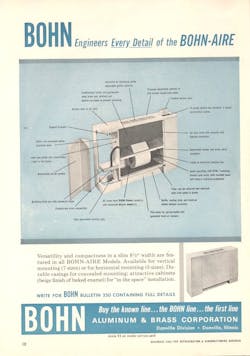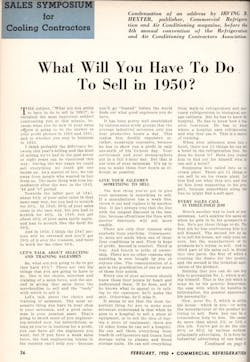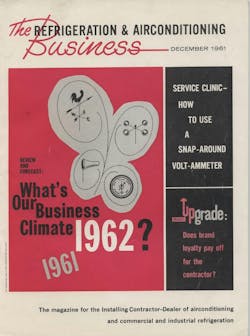The war years were well behind us, and by 1950, heating, air conditioning and commercial refrigeration had become established as important cogs in the wheel of commerce. And that included some of what at the time were out-of-the-ordinary applications.
In these early years of the post-war "baby boom", American life prospered, in ways reflected by expanding industries and communities.
On the cover of the July 1950 issue are a group of bowlers who were participating in the 1950 American Bowling Congress tournament, held in Columbus, Ohio. Indoor temperatures were making it difficult for the kegelers to kegel, so Frigidaire brought in 14 five-ton packaged air conditioners.
Each AC unit was installed in a 18-in. pit behind the bowlers, and all electrical and plumbing connections were grouped at the base of each unit. Temporary rubber drain pipes were used to connect the units to the water main and drain pipes. Strike!
Early "Mission Critical"
The "automatic electronic computer" -- also known as a mechanical brain. was developed at UCLA, where 35 tons of packaged air conditioning was installed to keep the first generation of computers cool and operating without fail.
Other equipment at the Institute of Numerical Analysis included more than a dozen electrical computing and card punching machines. Cooling for all of this was provided by seven five-hp GE air conditioning units.The photo shows one of the units used to cool the "brain machine" lab.
Many brands today incorrectly think it doesn't pay to advertise, but that wasn't the case in the 1950s and for 50 years forward. Honeywell was among the leading advertisers, with monthly ads for the fantastic and functional Honeywell thermostats taking lots of space. Notice the familiar keywords: "sell" "install" and "reduce call backs." Products would change over the decades, but key principles remained.
Larkin in now part of Heatcraft Refrigeration Products. In its early years it promoted a comprehensive line of air conditioning units, heat exchangers, coils for residential air conditioning, water-saving cooling towers and more.
BOHN promoted its dediction to engineering quality into each of its PTAC units."Versatility and compactness in a slim 81/2" width are featured in all BOHN-AIRE Models."
Commercial Refrigeration Magazine was dedicated to helping contractor-dealers grow their air conditioning businesses. In 1950, the staff ran a three-part "Sales Symposium for Cooling Contractors."
An article by publisher Irving B. Hexter focused on positive actions. Here's an excerpt:
Give Your Salesmen Something to Sell: "If a manufacturer has a weak line, throw it out and replace it by another line. It isn't always true that the line with the longest discount is the best line, because sometimes the lines with shorter discounts will sell more readily.
"When your salesman goes into a hotel, there are 13 things he can sell a hotel in the refrigeration line. But does he know it? Have you trained him to find out for himself what he can sell a hotel?
"Supposing he's called into an ice cream plant. There are 11 things he can sell in an ice cream plant. Let him find out what they are, and then let him keep suggesting this to his prospect, because somewhere along this line he might find a soft spot."
Moving forward to 1961, our Service Clinics got their start in these early years. And the technology is so much like today, only with a different look. This article on the volt-amp-ohm tester, "your serviceman's best friend", displayed four different ways to use it.
Before the advent of the AHR Trend Report, association executives shared predictions for the year to come. To accompany the "Review and Forecast" survey shown earlier, five association leaders shared their views on the coming 1962 business year. These should sound familiar. Nice to see their comments are free of any mention of environmental panic and government interference.
Walter McCarty, president, Refrigeration and Air Conditioning Contractors Association: "Qualified refrigeration and airconditioning contractors whould continue taking a larger share of the available business away from other contractors not primarily in this business. This trend started on the west coast and is not taking hold in the midwest. Two reasons: some of these other contractors have not found our business profitable and many customers are returning to the qualified refrigeration and airconditioning contractor because of dissatisfaction with the type of jobs they got from contractors not principally in this field."
Ray K. Serfass, president, Air-Conditioning and Refrigeration Institute (ARI): "Housing starts will be up modestly from about 1,300,000 to 1,375,000. Commercial construction is rising even now, and will continue to do so. Industrial construction is rising. All manufacture of durable doods is expected to rise."
E. Peter Sorensen, president, Air-Conditioning and Refrigeration Wholesalers. "Most wholesalers experienced a business slump in the first six months of 1961 due primarily to inclement weather and the general slowdown in the national economy. Last August our association started a monthly study of sales trends for our members. These reports have indicated a general rise in sale over the same period of 1960. With an improved economy and better weather conditions, sales shold continue to grow next year."
Donald D. Denny, president, National Commercial Refrigeration Sales Association: "Business looks good and dollar profit also should be good although profit percentage may be down. Today's picture is more volume and smaller margins. Competition is keen. Our business will be up because more and more of the smalle food market chains and voluntary groups are realizing that they can buy from a good distributor at less than they can buy direct."
Charles W. Lockhart, president, Air Moving and Conditioning Association: "Most of the manufacturers comprising our membership anticipate an increase in business for 1962. Profit increases are difficult to predict, but generally should be higher."
Next: "the modern supermarket" brings increased products and opportunities for installing and servicing contractors, and HVAC continues to grow.
Excerpt: SALES SLANTS on Air Conditioning by Leonard F. Auerbach, July 1950
"....Objections usually can be put into three categories. Some are sincere, but wrong. Your best bet is to straighten Mr. Prospect out immediately, but tactfully. Some are sincere and right. About all you can do is to work along the line of "Yes, that's right, but..." And some are baloney. Just anser those in the same vein as you get them.
"An old standby is that prices will come down. Right now, prospects point to tumbling television prices as an example. It doesn't look as though our prices will come down (and that point should be made), but let's concede for a moment they they might. Is it probable that in a 12-month period a $2000 installation could come down over $200? Man alive, that's just one year's amortization, so the prospect's net saving y waiting a year will be no more than his annual expense of owning the installation. Pick the ball up from there and start finding a good location for the equipment....."
About the Author
Terry McIver
Content Director - CB
As director of content for Contracting Business, he produces daily content and feature articles for CB's 38,000 print subscribers and many more Internet visitors. He has written hundreds, if not two or three, pieces of news, features and contractor profile articles for CB's audience of quality HVACR contractors. He can also be found covering HVACR industry events or visiting with manufacturers and contractors. He also has significant experience in trade show planning.
